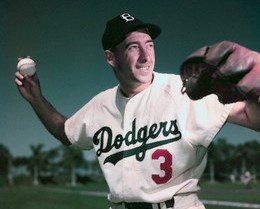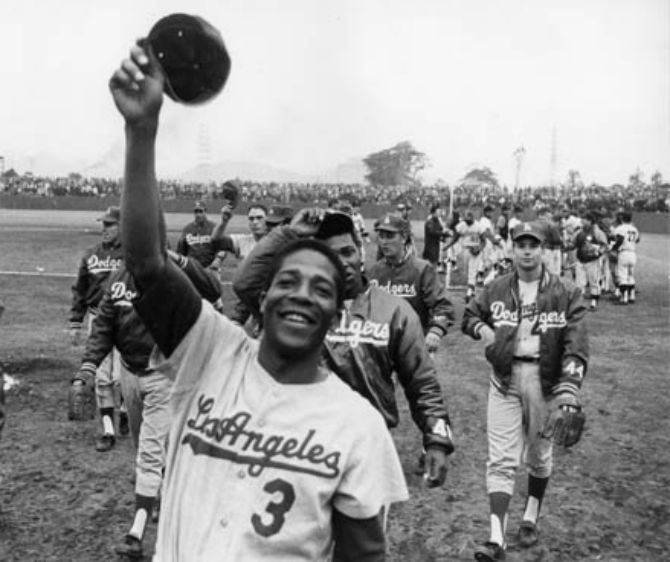|
This is the 59th season of the Brooklyn Dodgers out west; I think I am adjusting.
I’ve been staying up late watching the Mets and Dodgers, the two teams in my life, do battle in distant Chávez Ravine. The shock now is the familiar numbers on the home white jerseys -- with strange people wearing them. I know Seinfeld said rooting for a team is “actually rooting for the clothes when you get right down to it." So be it. I admit: I am still attached to the Dodgers’ laundry – or more specifically the numbers on them. But who are these new people? The Dodgers have retired 10 numbers, including Jackie Robinson’s No. 42, but they fall way short of the Yankees, who have retired 22 numbers, including Robinson’s, and a duplicate No. 8 for Yogi Berra and Bill Dickey. The Yankees are always looking for more numbers to retire for another one-day jolt in attendance. Eddie Whitson Day is coming up soon. By contrast, the Dodgers have been conservative – Gil Hodges’ No. 14 is still used and so is the No, 36 once worn by Don Newcombe, who still serves their community and anti-addiction efforts. I am sure the shock is not confined to old people like me. Kids who became fans in the 1980s are stunned to see somebody else wearing Pedro Guerrero’s No. 28. I’m on my third or fourth shift with the Dodgers’ laundry. Let’s take No. 3. In my childhood, it was worn by Billy Cox, with his ratty glove, picking everything at third base -- Clete Boyer and Brooks Robinson before they were invented. Cox played only seven seasons in Brooklyn, from 1948 through 1954, but it seemed like seven decades. Kids, that’s the way it is when you are young. Fast forward to the 60’s, when I was a young reporter and the Dodgers’ center fielder, Willie Davis, could manufacture a run with a few long strides – walk, steal, bad throw, sacrifice fly. Davis had one bad World Series game in the sun in 1965 but he was a terrific player. I also remember Willie Davis for coming after me in the clubhouse in the tense days after the Watts disturbances in 1965, because he didn’t like my questioning. John Roseboro, noble knight of a catcher, stepped into Davis’ path and calmed things down, or I might not be typing these words. (Roseboro’s reward was being bopped on the head by Juan Marichal that August.) Nowadays, No. 3 is assigned to Carl Crawford, sliding downhill from his early promise. I did some research on all the Dodgers who have won No. 3: In the wartime season of 1944, No. 3 was worn by two infielders, Al Campanis and Gene Mauch, who would later become a general manager and manager in the majors. In 1977-78, No. 3 was worn by Glenn Burke, who years later revealed he was gay, and who died young. One other Dodger No. 3: Pete Coscarart, an outfielder from 1938 through 1941, who nearly half a century later was among the old-time players virtually begging the Players Association to include them in their lush pension plan. Pete once wrote me: “George, they are waiting for us to die.” Just to annoy the association, he hung on until June 24, 2002, when he died, at 89, without the Association budging on pensions. I could tell you about No. 10, which, from the very first season of numbers in Brooklyn, was worn almost exclusively by catchers. I have never heard of one number being dominated by one position like that. From 1932 through 1970, the catchers included Al Lopez, Bruce Edwards, Rube Walker and Jeff Torborg. But in 1971, No. 10 went to squatty Ron Cey, a third baseman known as Penguin, who held it until 1982. No. 10 is currently worn by Justin Turner, with his red Yosemite Sam beard, who has spent recent evenings chatting with his old teammates on the Mets. I haven’t even mentioned Sandy Koufax – but let’s end with Ry Cooder’s song about the Mexicans who used to live in Chávez Ravine: “Second base right over there/I see Grandma in her rocking chair.”) I don’t believe the ejected squatters ever had their number retired.
Michael Green
5/13/2016 03:40:07 pm
Lovely piece. My mother grew up a Brooklyn Dodgers fan and she and my dad, having met in southern California, made me a Dodger fan.
George Vecsey
5/13/2016 04:52:47 pm
Michael, thanks for the great not.
Michael Green
5/14/2016 02:01:31 pm
Mr. Vecsey, thanks for YOUR comment. And I do think if Campy had not been in that accident, he had a future in managing if he wanted it. In fact, when Walter Alston was his minor league manager in Nashua and was thrown out of a game, he handed the lineup card to Campy to take over because he was the senior guy there.
Joel Gardner
5/14/2016 08:25:24 pm
Willie Davis was the greatest high school athlete I ever saw. He attended Roosevelt High in East LA. Was an all-city basketball player. Won the sprints and led the relays at the state track championships, with a 9.5 100 and a 20.5 220. And, like Jackie Robinson, he would run from track meets to baseball games. He probably would have played football if it had been allowed by California Interscholastic Federation rules. Another note: the Roosevelt team featured Willie and another African American, a Japanese point guard, a Jewish player at the 2 guard, and a Chicano at the other forward. Willie jumped center--at 6'2".
George Vecsey
5/15/2016 08:49:09 pm
Dear Joel Gardner: Thanks for the note.
Joel Gardner
5/16/2016 07:13:32 pm
I forgot to mention that Willie also won the long jump and the high jump.
George Vecsey
5/16/2016 07:36:43 pm
The other part of the story Dick told is that Lefty James, Cornell football coach, wandered out to watch a Cornell-Syracuse lacrosse game and blurted, "They let him carry a stick?" Brown was so big and strong. My pal in my town says one of his FB teammates tackled Brown in a high school game "and was never the same." 11/30/2016 05:14:18 am
I am totally agree with this dodgers numbers persist generation come and go .Indeed it make sense. Comments are closed.
|
Categories
All
|











